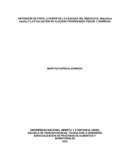Mostrar el registro sencillo del ítem
Obtención de papel a partir de la cáscara del maracuyá (Passiflora edulis) y la evaluación de algunas propiedades físicas y químicas.
| dc.contributor.advisor | Perdomo Cerquera, July Constanza | |
| dc.coverage.spatial | udr_-_Barrancabermeja | spa |
| dc.creator | Aparicio, Martha Patricia | |
| dc.date.accessioned | 2020-06-30T03:50:40Z | |
| dc.date.available | 2020-06-30T03:50:40Z | |
| dc.date.created | 2019-03-16 | |
| dc.identifier.uri | https://repository.unad.edu.co/handle/10596/35090 | |
| dc.description.abstract | La producción de papel está soportada principalmente en la madera debido a su alto contenido de celulosa. Sin embargo, actualmente se buscan fuentes alternativas que desestimulen el uso de este recurso favoreciendo la protección de los recursos. El papel consiste en un gel de fibra - aire, obtenido a partir de materias primas vegetales que presentan una cantidad considerable de celulosa (más del 40% en peso en base seca). El principal constituyente sólido del papel es la celulosa, cuyas fibras se unen entre sí por medio de puentes de hidrógeno; estas fibras están presentes en las especies vegetales que hacen parte de los residuos orgánicos. En Colombia más del 63% de los residuos que se generan son de carácter orgánico y muy pocos se están aprovechando debido a la falta de conocimiento y prácticas de aprovechamiento. Esta investigación se centró en determinar a través de pruebas de laboratorio la caracterización fisicoquímica en la muestra vegetal (contenido de celulosa, hemicelulosa y lignina), así mismo se adecuo condiciones del proceso para la elaboración de papel a partir de las cáscaras del maracuyá, se aplicó el método estadístico Genechi Taguchi y con base a los resultados se seleccionó mejor formulación, se determinó las propiedades fisicoquímicas del papel obtenido (humedad, resistencia, absorción, color, textura y apariencia) se realizó un análisis para concluir que este tipo de residuo tiene alto potencial para ser usado como una alternativa viable en la producción de papel. Capítulo I: Por medio de antecedentes se evaluó el problema, buscando sus causas, efectos y posibles soluciones, los objetivos que persigue, delimitándolo y explicando la situación y ubicación del mismo. Se detalló un marco teórico, mediante las fundamentaciones bibliográficas que permitirá al lector entender el proceso de la investigación y la propuesta desarrollada. Capítulo II: La metodología de la investigación, se determinó la modalidad, el tipo y las herramientas de investigación que ayudaron a descubrir la población y su muestra. Capítulo III: Se detallaron todos los resultados interpretando mediante los datos obtenidos. Capítulo IV: Se detallaron las conclusiones y recomendaciones del proyecto. | spa |
| dc.format | ||
| dc.title | Obtención de papel a partir de la cáscara del maracuyá (Passiflora edulis) y la evaluación de algunas propiedades físicas y químicas. | |
| dc.type | Proyecto aplicado | |
| dc.subject.keywords | Industria alimentaria, Celulosa, Fibra, Residuo orgánico, Aprovechamiento, Materia prima, Papel | spa |
| dc.description.abstractenglish | Paper production is mainly supported by wood due to its high cellulose content. However, alternative sources are currently being sought that discourage the use of this resource, favoring the protection of resources. The paper consists of a fiber-air gel, obtained from vegetable raw materials that have a considerable amount of cellulose (more than 40% by weight on a dry basis). The main solid constituent of paper is cellulose, the fibers of which are linked together by hydrogen bonds; These fibers are present in plant species that are part of organic waste. In Colombia, more than 63% of the waste generated is organic and very few are being used due to the lack of knowledge and use practices. This research focused on determining through laboratory tests the physicochemical characterization in the plant sample (content of cellulose, hemicellulose and lignin), as well as the process conditions for the preparation of paper from the passion fruit peels, it was adapted The statistical method Genechi Taguchi was applied and based on the results, a better formulation was selected, the physicochemical properties of the obtained paper were determined (humidity, resistance, absorption, color, texture and appearance). An analysis was carried out to conclude that this type of residue has high potential to be used as a viable alternative in paper production. Chapter I: by means of antecedents the problem was evaluated, looking for its causes, effects and possible solutions, the objectives that it pursues, delimiting it and explaining the situation and location of it. A theoretical framework was detailed, through the bibliographical foundations that will allow the reader to understand the research process and the proposal developed. Chapter II: The methodology of the investigation, the modality, the type and the research tools that helped to discover the population and its sample were determined. Chapter III: All the results were detailed interpreting through the obtained data. Chapter IV: The conclusions and recommendations of the project were detailed. | spa |















